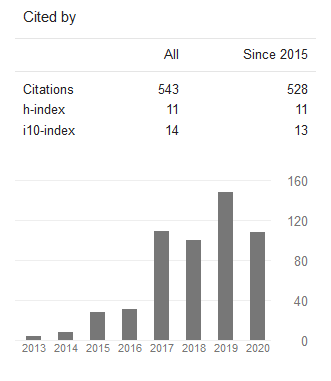Gamified Distance Learning Application Design for Enhanced Student Engagement and User Experience
DOI:
https://doi.org/10.24002/jbi.v15i1.8737Keywords:
distance learning, gamification, User Experience Questionnaire, User Engagement Scale, pembelajaran jarak jauh, gamifikasiAbstract
Distance Learning in Indonesia is one of the learning methods that began to be applied during the Covid-19 pandemic. Yet students face some obstacles, such as lack of motivation, struggling with operating learning devices, difficulty maintaining focus, and student engagement during the learning process. Gamification offers a solution to these problems by significantly enhancing user motivation and engagement, as it has been tested in research to have a profound impact. Therefore, this study aims to design a mobile application for Distance Learning by implementing gamification. It employs qualitative and quantitative data, including 32 students' responses from questionnaires like UEQ-S, utilized for testing user interface, and UES-SF, employed for testing gamification elements. By implementing gamification in this design, an engagement score of 83% was obtained, and the overall UEQ-S result was 1.89 in the Excellent category.
References
S. Olivia, J. Gibson, and R. Nasrudin, “Indonesia in the Time of Covid-19,” Bull Indones Econ Stud, vol. 56, no. 2, pp. 143–174, May 2020, doi: 10.1080/00074918.2020.1798581.
S. Setiati and M. K. Azwar, “COVID-19 and Indonesia,” Acta Medica Indonesiana The Indonesian Journal of Internal Medicine, vol. 52, no. January, 2020, [Online]. Available: https://www.actamedindones.org/index.php/ijim/article/view/1426
M. Churiyah, S. Sholikhan, F. Filianti, and D. A. Sakdiyyah, “Indonesia Education Readiness Conducting Distance Learning in Covid-19 Pandemic Situation,” International Journal of Multicultural and Multireligious Understanding, vol. 7, no. 6, p. 491, Aug. 2020, doi: 10.18415/ijmmu.v7i6.1833.
B. M. Batubara, “The Problems of the World of Education in the Middle of the Covid-19 Pandemic,” Budapest International Research and Critics Institute (BIRCI-Journal): Humanities and Social Sciences, vol. 4, no. 1, pp. 450–457, Jan. 2021, doi: 10.33258/birci.v4i1.1626.
E. Munastiwi and S. Puryono, “Unprepared management decreases education performance in kindergartens during Covid-19 pandemic,” Heliyon, vol. 7, no. 5, p. e07138, 2021, doi: 10.1016/j.heliyon.2021.e07138.
J. Jamilah and E. F. Fahyuni, “The Future of Online Learning in the Post-COVID-19 Era,” KnE Social Sciences, pp. 497–505, Jun. 2022, doi: 10.18502/kss.v7i10.11251.
S. Muangsrinoon and P. Boonbrahm, “Game elements from literature review of gamification in healthcare context,” J Technol Sci Educ, vol. 9, no. 1, pp. 20–31, 2019, doi: 10.3926/jotse.556.
J. Koivisto and J. Hamari, “The rise of motivational information systems: A review of gamification research,” Int J Inf Manage, vol. 45, no. July 2018, pp. 191–210, 2019, doi: 10.1016/j.ijinfomgt.2018.10.013.
J. Majuri, J. Koivisto, and J. Hamari, “Gamification of education and learning: A review of empirical literature,” CEUR Workshop Proc, vol. 2186, no. GamiFIN, pp. 11–19, 2018.
A. N. Saleem, N. M. Noori, and F. Ozdamli, “Gamification Applications in E-learning: A Literature Review,” Technology, Knowledge and Learning, vol. 27, no. 1, pp. 139–159, 2022, doi: 10.1007/s10758-020-09487-x.
A. Steinmaurer, J. Pirker, and C. Gütl, “sCool – Game-Based Learning in Computer Science Class: A Case Study in Secondary Education,” International Journal of Engineering Pedagogy (iJEP), vol. 9, no. 2, p. 35, Apr. 2019, doi: 10.3991/ijep.v9i2.9942.
J. Jayalath and V. Esichaikul, “Gamification to Enhance Motivation and Engagement in Blended eLearning for Technical and Vocational Education and Training,” Technology, Knowledge and Learning, vol. 27, no. 1, pp. 91–118, 2022, doi: 10.1007/s10758-020-09466-2.
N. Jaftha, “Improved Students’ Performance within Gamified Learning Environment: A Meta-Analysis Study,” International Journal of Education and Research, vol. 8, no. January, pp. 223–244, 2020.
N. Z. Legaki, N. Xi, J. Hamari, K. Karpouzis, and V. Assimakopoulos, “The effect of challenge-based gamification on learning: An experiment in the context of statistics education,” International Journal of Human Computer Studies, vol. 144, Dec. 2020, doi: 10.1016/j.ijhcs.2020.102496.
H. Y. Kwon and K. Özpolat, “The dark side of narrow gamification: Negative impact of assessment gamification on student perceptions and content knowledge,” INFORMS Transactions on Education, vol. 21, no. 2, pp. 67–81, 2021, doi: 10.1287/ITED.2019.0227.
A. Torres-Toukoumidis, P. Carrera, I. Balcazar, and G. Balcazar, “Descriptive Study of Motivation in Gamification Experiences from Higher Education: Systematic Review of Scientific Literature,” Universal Journal of Educational Research, vol. 9, no. 4, pp. 727–733, 2021, doi: 10.13189/ujer.2021.090403.
R. van Roy and B. Zaman, “Why gamification fails in education - and how to make it successful,” Serious Games and Edutainment Applications: Volume II, no. October, pp. 1–702, 2017, doi: 10.1007/978-3-319-51645-5.
R. Trigueros, J. M. Aguilar-Parra, R. López-Liria, and P. Rocamora, “The dark side of the self-determination theory and its influence on the emotional and cognitive processes of students in physical education,” Int J Environ Res Public Health, vol. 16, no. 22, 2019, doi: 10.3390/ijerph16224444.
N. Razali, N. A. Nasir, M. E. Ismail, N. M. Sari, and K. M. Salleh, “Gamification Elements in Quizizz Applications: Evaluating the Impact on Intrinsic and Extrinsic Student’s Motivation,” IOP Conf Ser Mater Sci Eng, vol. 917, no. 1, 2020, doi: 10.1088/1757-899X/917/1/012024.
J. C. Y. Sun and P. H. Hsieh, “Application of a gamified interactive response system to enhance the intrinsic and extrinsic motivation, student engagement, and attention of English learners,” Educational Technology and Society, vol. 21, no. 3, pp. 104–116, 2018.
A. Manzano-León et al., “Between level up and game over: A systematic literature review of gamification in education,” Sustainability (Switzerland), vol. 13, no. 4, pp. 1–14, 2021, doi: 10.3390/su13042247.
P. Bitrián, I. Buil, and S. Catalán, “Enhancing user engagement: The role of gamification in mobile apps,” J Bus Res, vol. 132, no. April, pp. 170–185, 2021, doi: 10.1016/j.jbusres.2021.04.028.
H. L. O’Brien, P. Cairns, and M. Hall, “A practical approach to measuring user engagement with the refined user engagement scale (UES) and new UES short form,” International Journal of Human Computer Studies, vol. 112, no. February, pp. 28–39, 2018, doi: 10.1016/j.ijhcs.2018.01.004.
E. N. Wiebe, A. Lamb, M. Hardy, and D. Sharek, “Measuring engagement in video game-based environments: Investigation of the User Engagement Scale,” Comput Human Behav, vol. 32, pp. 123–132, 2014, doi: 10.1016/j.chb.2013.12.001.
A. García-Jurado, M. Torres-Jiménez, A. L. Leal-Rodríguez, and P. Castro-González, “Does gamification engage users in online shopping?,” Electron Commer Res Appl, vol. 48, 2021, doi: 10.1016/j.elerap.2021.101076.
I. Díaz-Oreiro, G. López, L. Quesada, and L. Guerrero, “Standardized Questionnaires for User Experience Evaluation: A Systematic Literature Review,” no. October 2018, p. 14, 2019, doi: 10.3390/proceedings2019031014.
M. Schrepp, A. Hinderks, and J. Thomaschewski, “Design and Evaluation of a Short Version of the User Experience Questionnaire (UEQ-S),” International Journal of Interactive Multimedia and Artificial Intelligence, vol. 4, no. 6, p. 103, 2017, doi: 10.9781/ijimai.2017.09.001.
D. Anton, G. Kurillo, and R. Bajcsy, “User experience and interaction performance in 2D/3D telecollaboration,” Future Generation Computer Systems, vol. 82, pp. 77–88, 2018, doi: 10.1016/j.future.2017.12.055.
R. K. Sari and S. Nurani, “Quizizz atau Kahoot! Gamifikasi dalam Pembelajaran Bahasa Inggris,” Jurnal Pendidikan dan Kebudayaan, vol. 1, no. 3, pp. 78–86, 2021.
P. Paradise, M. Wibowo, and M. Wibowo, “Pengembangan Learning Management System (LMS) dengan Menerapkan Video Based Learning dan Gamification Dalam Meningkatkan Motivasi dan Keterlibatan Mahasiswa,” Jurnal Media Informatika Budidarma, vol. 5, no. 3, p. 929, 2021, doi: 10.30865/mib.v5i3.3087.
B. Nadeak, “The Effectiveness of Distance Learning Using Social Media during the Pandemic Period of COVID-19: A Case in Universitas Kristen Indonesia,” International Journal of Advanced Science and Technology, vol. 29, no. 7, pp. 1764–1772, 2020.
L. Husniah, B. F. Pratama, and H. Wibowo, “Gamification And GDLC (Game Development Life Cycle) Application For Designing The Sumbawa Folklore Game ”The Legend Of Tanjung Menangis (Crying Cape)”,” Kinetik: Game Technology, Information System, Computer Network, Computing, Electronics, and Control, vol. 3, no. 4, pp. 351–358, 2018, doi: 10.22219/kinetik.v3i4.721.
A. Fairuzabadi and A. A. Supianto, “An Overview Of Learning Support Factors On Mathematic Games,” Kinetik: Game Technology, Information System, Computer Network, Computing, Electronics, and Control, vol. 4, no. 2, pp. 169–178, 2019, doi: 10.22219/kinetik.v4i2.761.
M. Schrepp, A. Hinderks, and J. Thomaschewski, “Applying the user experience questionnaire (UEQ) in different evaluation scenarios,” Lecture Notes in Computer Science (including subseries Lecture Notes in Artificial Intelligence and Lecture Notes in Bioinformatics), vol. 8517 LNCS, no. PART 1, pp. 383–392, 2014, doi: 10.1007/978-3-319-07668-3_37.
H. Aziz, Misbahul; Pramana, Edwin; Junaedi, “Adoption of mobile learning at Universities using the extended technology acceptance model,” Kinetik: Game Technology, Information System, Computer Network, Computing, Electronics, and Control, vol. 7, no. 4, pp. 337–348, 2022, doi: 10.22219/kinetik.v7i4.1522.
Downloads
Published
Issue
Section
License

This work is licensed under a Creative Commons Attribution-ShareAlike 4.0 International License.
Copyright of this journal is assigned to Jurnal Buana Informatika as the journal publisher by the knowledge of author, whilst the moral right of the publication belongs to author. Every printed and electronic publications are open access for educational purposes, research, and library. The editorial board is not responsible for copyright violation to the other than them aims mentioned before. The reproduction of any part of this journal (printed or online) will be allowed only with a written permission from Jurnal Buana Informatika.
This work is licensed under a Creative Commons Attribution-ShareAlike 4.0 International License.










